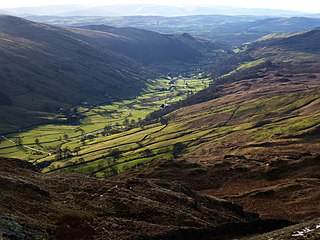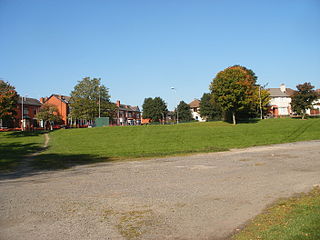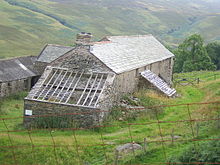
Withnail and I is a 1987 British black comedy film written and directed by Bruce Robinson. Loosely based on Robinson's life in London in the late 1960s, the plot follows two unemployed actors, Withnail and "I" who share a flat in Camden Town in 1969. Needing a holiday, they obtain the key to a country cottage in the Lake District belonging to Withnail's eccentric uncle Monty and drive there. The weekend holiday proves less recuperative than they expected.

Bruce Robinson is an English actor, director, screenwriter and novelist. He wrote and directed Withnail and I (1987), a film with comic and tragic elements set in London in the late 1960s, which drew on his experiences as a struggling actor, living in poverty in Camden Town.

Longsleddale is a valley and civil parish in the South Lakeland district of Cumbria, England. It includes the hamlet of Sadgill. The parish has a population of 73. As the population taken at the 2011 Census was less than 100, details are maintained in the civil parish of Whitwell and Selside.

Housesteads Roman Fort was an auxiliary fort on Hadrian's Wall, at Housesteads, Northumberland, England. It is dramatically positioned on the end of the mile-long crag of the Whin Sill over which the Wall runs, overlooking sparsely populated hills. It was called the "grandest station" on the Wall and is one of the best-preserved and extensively displayed forts. It was occupied for almost 300 years. It was located 5.3 miles west from Carrawburgh fort, 6 miles east of Great Chesters fort and about two miles north east of the existing fort at Vindolanda on the Stanegate road.

Hindley is a small hamlet, comprising around 20 residences. It is in the parish of Stocksfield and is just to the south of Stocksfield in Northumberland with Broomley to the west and Whittonstall to the east. It is south of the River Tyne. Hindley is composed of a large house, Hindley Hall, a farm and a post box.

Shap is a village and civil parish located among fells and isolated dales in Westmorland and Furness, Cumbria, England. The village is in the historic county of Westmorland. The parish had a population of 1,221 in 2001, increasing slightly to 1,264 at the 2011 Census.

Dunham Massey is a civil parish in the Metropolitan Borough of Trafford, Greater Manchester, England. The parish includes the villages of Sinderland Green, Dunham Woodhouses and Dunham Town, along with Dunham Massey Hall and Park, formerly the home of the last Earl of Stamford and owned by the National Trust since 1976. Dunham Massey is in the historic county of Cheshire, but since 1974 has been part of Trafford Metropolitan Borough; the nearest town is Altrincham. At the 2001 census, the parish had a population of 475.

Shap Rural is a very large, but sparsely populated, civil parish in the Eden district of Cumbria in England, covering part of the Lake District National Park. It had a population of 119 in 2001, 130 at the 2011 Census, and 110 in 2021.

Tarbock is a village and former civil parish within the Metropolitan Borough of Knowsley, in Merseyside, England. It is situated to the south east of Huyton and to the east of Netherley. The village itself is 6 miles (9.7 km) from Liverpool city centre, 3.5 miles (5.6 km) from Widnes and 2 miles (3.2 km) from Prescot. The M62 motorway junction 6 is in the area and is more familiarly called Tarbock Island. At the 2001 Census, the population of Tarbock was 2,382. The parish council was abolished on 1 April 2014.

Shakerley is a suburb of Tyldesley in the Metropolitan Borough of Wigan, Greater Manchester, England. It was anciently a hamlet in the northwest of the township of Tyldesley cum Shakerley, in the ancient parish of Leigh. The boundary between Shakerley and Hindsford is the Hindsford Brook. It remains the boundary between Tyldesley and Atherton. Hyndforth Bridge across the brook, was rebuilt in stone in 1629.

Rivington in the Borough of Chorley, Lancashire, is situated on the edge of the West Pennine Moors, at the foot of Rivington Pike overlooking reservoirs created for Liverpool Corporation Waterworks in the 19th century. There are twenty eight listed buildings within Rivington, two are classified by English Heritage as Grade II*, the rest as Grade II; Rivington has no Grade I Listed buildings.

West House is a Grade II* listed Queen Anne revival house at 35 Glebe Place, Chelsea, London. It was built in 1868–69 by the architect Philip Webb, on behalf of the artist George Price Boyce. It was extended in 1876 by Webb, and in 1901 by an unknown architect. Historic England have described West House as "one of the earliest examples of the Queen Anne Revival style". West House possesses one of the few triple-height ceilings in London.
Bernard Nevill FRSA FCSD was a British designer and academic, formerly a professor at Saint Martin's School of Art and design director for Liberty of London.

The Lowbridge Estate is a country estate of approximately 2000 acres in the Lake District region of England that was in the continuous ownership of the Fothergill family from 1761. Lowbridge House, the principal house on the estate, was built in the 1830s by Richard Fothergill II (1789–1851) in the cottage orné style. The property was substantially updated and improved in 1889 and again in 2017 to 2019. The property lies between Todd Crag and Bannisdale. Other properties on the Estate include Lowbridge Cottage, Lowbridge Lodge and the Bridge House. The Estate has become a haven for red squirrels with a very active policy of conservation including the extensive planting of red squirrel friendly larch trees and the reintroduction of pine-martins.
Shap is a civil parish in the Eden District, Cumbria, England. It contains 31 listed buildings that are recorded in the National Heritage List for England. Of these, one is listed at Grade II*, the middle of the three grades, and the others are at Grade II, the lowest grade. The parish contains the village of Shap, the hamlet of Keld, and the surrounding countryside. Most of the listed buildings are houses and associated structures, farmhouses and farm buildings. The other listed buildings include a church and items in the churchyard, a chapel, a hotel, a former market hall, a war memorial, and four mileposts.
Shap Rural is a civil parish in the Eden District, Cumbria, England. It contains eleven listed buildings that are recorded in the National Heritage List for England. All the listed buildings are designated at Grade II, the lowest of the three grades, which is applied to "buildings of national importance and special interest". The parish is almost entirely rural, and the listed buildings consist of farm houses and farm buildings, three bridges, a lime kiln, and a monument.
Aspull is a village in the Metropolitan Borough of Wigan, Greater Manchester, England. The village and the surrounding countryside contain 21 listed buildings that are recorded in the National Heritage List for England. Of these, one is listed at Grade II*, the middle of the three grades, and the others are at Grade II, the lowest grade.
Adel and Wharfedale is a ward in the metropolitan borough of the City of Leeds, West Yorkshire, England. It contains 40 listed buildings that are recorded in the National Heritage List for England. Of these, one is listed at Grade I, the highest of the three grades, and the others are at Grade II, the lowest grade. The ward is to the north of the centre of Leeds, and contains the areas of Adel and Cookridge, and countryside to the north. The ward contains St John's Church, which is listed at Grade I, and associated buildings and monuments in the churchyard are listed. Also in the ward is Lawnswood Cemetery, which contains listed buildings and memorials, including a war memorial. In the ward is Cookridge Hall, which is listed together with associated structures. The other listed buildings include houses, farmhouses and farm buildings, two milestones, a public house, and a former reform school.















